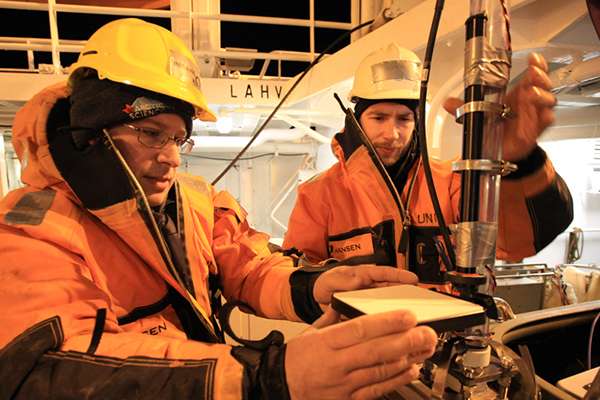Autonomous kayak helps researchers capture light measurements in winter Arctic

Circadian rhythms are the daily 24-hour cycles that tell our bodies when to eat, sleep and regulate a host of other physical processes. They can be affected by environmental cues like light and temperature.
Marine organisms are susceptible to light, too. They use it to find food, avoid predators, even to hide themselves in plain sight.
But in places like the Svalbard, Norway, which experience near continuous darkness in the winter months, light can be hard to come by when the sun remains below the horizon in the high Arctic during the polar night.
Jonathan Cohen, a marine bioscience assistant professor in the University of Delaware's College of Earth, Ocean, and Environment, has been studying how winter darkness affects biological processes and marine organisms like krill in this region of the world for the past two years.
Scientists know very little about the light regime at this time of year, except to say that light is an important ecological factor in the polar night.
In January 2015, he spent four weeks measuring how much light was in the atmosphere, and then modeled how that light entered the water, and how much light was available to marine organisms at certain depths.
Last month, Cohen and UD doctoral student Corie Charpentier returned to the marginal ice zone north of Svalbard aboard the R/V Helmer Hanssen on a new mission – to help fill the gap in scientific knowledge by deploying sensitive light measurement equipment out on an autonomous kayak along with another instrument that uses sound to measure positions of animals underwater.
According to Cohen, it was both an exciting and nerve racking endeavor.
"We programmed the kayak to repeatedly move back and forth in Kongsfjord, away from the ship and all the light and noise it produces. This let us simultaneously measure light before and after solar noon, and the movement response of animals in the water column to that light. The results were striking, and show how disruptive the presence of the ship can be when measuring activity of animals in the water," Cohen said.
Many animals use light to find food, but some also use light to set their vertical position in the water. Krill and copepods, for instance, move deeper into the water during the daytime when light from the atmosphere is strongest, and venture closer to the surface as the light dims at dusk.
Cohen is interested in understanding how a warming Arctic—which will allow more light to penetrate the water due to the melting of Arctic ice—will affect these species and others marine animals. For example, if the animals retreat deeper into the water column in response to the increased light, will this change in position alter food web interactions?
The work is part of a broader project currently underway through funding from the Norwegian Research Council.
Deep-sea eyes
Meanwhile, Charpentier measured the visual sensitivity of krill and amphipods (small, shrimp-like crustaceans) to learn how much light they need to see and to what extent visual interactions can happen in the winter. She accomplished this by interpreting the animals' electrical responses to flashes of different intensities and wavelengths, or colors, of light.
"If I flash a light at an animal's eye, I can record the electrical signal similar to the way an EKG records the electrical signals produced when your heart beats," said Charpentier, who is also an environmental fellow with UD's Delaware Environmental Institute (DENIN).
Interestingly, what she learned is that krill are more sensitive to light at night than during the day. This tells the scientists' that krill are synchronizing aspects of their physiology to the light cycle of the sun, a pretty amazing feat considering how little daily variation in light occurs in the region at this time of year.
"The light cycle in the Arctic doesn't seem very defined to the human eye, so it was surprising to find differences between the animal's daytime and nighttime responses," said Charpentier. "We are seeing these patterns, now we have to find out why this is happening."
Future work
Later this year, Cohen and colleagues from University of Tromsø, University Centre in Svalbard, and Norwegian University of Science and Technology, among other institutions, hope to deploy four ice-tethered observatories on a one-year journey through the Arctic that will extend well beyond where scientists can go.
Two observatories will measure light, temperature and salinity near the ice/water interface; one will measure ice and snow thickness; and the final observatory will measure zooplankton and fish distributions in the water column (surface to 200 meters) using the same acoustic instruments deployed in January on the autonomous kayak.
Cohen is particularly interested in the timing of ice algae development. It's important he said, because it starts the seasonal process of biology in the Arctic.
"Over the winter, algae become frozen in the ice. As the temperature warms and light penetrates the water, algae begin to grow. Things eat the algae (like zooplankton); fish eat the organisms that eat the ice algae and so on up the food web. When the ice melts, all of this marine life falls into the water column, where it feeds the rest of the marine food web or sinks to the ocean floor and becomes part of the sediment or the benthic community," Cohen explained.
Using a hyperspectral camera, the researchers plan to investigate what species are present in the ice algae that develops in the underside of the ice, because different species have different spectral signatures depending on the pigments in the algae used to absorb light.
"We are trying to understand this process in finer detail and look at how it's related to the amount and spectrum of light; and then consider what seasonality will be like in an Arctic environment where there is less sea ice and more light," he said.
Provided by University of Delaware




















